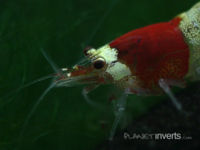Difference between revisions of "Caridina cf. cantonensis"
From The Aquarium Wiki
Edwardbelli (talk | contribs) m (→Alternative names) |
TheShrimpGuy (talk | contribs) |
||
| Line 94: | Line 94: | ||
==Commercial Sellers== | ==Commercial Sellers== | ||
| + | *[https://podvodoyaquatics.com] - USA Seller | ||
*[http://breedinusa.com BreedInUSA.com] - USA Breeder & Seller | *[http://breedinusa.com BreedInUSA.com] - USA Breeder & Seller | ||
*[http://www.theshrimpspot.com The Shrimp Spot] - Worldwide Seller of Freshwater Shrimp | *[http://www.theshrimpspot.com The Shrimp Spot] - Worldwide Seller of Freshwater Shrimp | ||
| Line 99: | Line 100: | ||
== External links == | == External links == | ||
| + | *[https://podvodoyaquatics.com] - USA Seller | ||
*[http://www.shrimpkeeping.com Shrimp Keeping] - The Home of Freshwater Shrimp | *[http://www.shrimpkeeping.com Shrimp Keeping] - The Home of Freshwater Shrimp | ||
*[http://breedinusa.com/shop/en/shrimps/11-crystal-red-shrimp-crs-s-grade.html BreedInUSA.com] - US Seller: Crystal Red Shrimp | *[http://breedinusa.com/shop/en/shrimps/11-crystal-red-shrimp-crs-s-grade.html BreedInUSA.com] - US Seller: Crystal Red Shrimp | ||
Revision as of 17:47, 2 September 2020
Bee Shrimp
Caridina cantonensis sp.
19 Litres (5 US G.)
2-3 cm (0.8-1.2")
Freshwater
6.2 - 7.2
20-24.4°C (68 -76 °F)
1-4 °d
2:3 M:F
1-2 years
This animal is available captive bred
Contents
Alternative names
- Bee Shrimp, Black Bee, Crystal Black Shrimp (original species often called CBS), Crystal Red Shrimp (colour mutation of the Black shrimp often called CRS).
Synonyms
- Caridina cantonensis sp. "Crystal Red", Caridina cantonensis sp. "Bee", Caridina cantonensis sp. "Black Tiger", Caridina cantonensis sp "blue", Caridina cantonensis sp. "Golden Bee", Caridina cantonensis sp. "Orange Bee"
Species Notes
- There are many selectively-bred colour morphs of the Bee Shrimp, established in 1991, it will commonly be found in stores as the Crystal Red Shrimp or CRS, the red/white variant. It is exactly the same as the Bee Shrimp but is now being bred separately for the colour.
- The Crystal Red genetic mutation was discovered in Japan in 1996 and was registered as a trademark in that country. It is like the Crystal Black but with red bands instead
Grading
- Crystal Red Shrimp/Crystal Black Shrimp have different grades. In order from lowest to highest, the grades are: C, B, A, S, SS, and SSS. The higher the grade, the more white it has and the more expensive it is. Visit external link below for grading information.
Other Morphs
- Other selectively bred morphs are appearing on the market regularly, including the Black Tiger Shrimp with a black body and red eyes. Also the Blue Tiger Shrimp with a very dark blue body and orange eyes.
- The Orange Bee Shrimp has very similar markings to the Tiger Shrimp but with a very orange body.
- The Golden Bee Shrimp has a solid white/cream body. It may also be called the Golden Crystal Red Shrimp or Snow White Crystal Red Shrimp.
- Many of these morphs may be reclassified with their own Caridina names as more is discovered about them.
Sexing
- The difference in sex is quite obvious in adult animals, especially if one can compare male and female.
- Adult females are 10-30% larger than adult males.
- Females have substantially larger scales on the abdomen (See image on the right)
- Before laying eggs, the female's ovaries are visible in the 'head' and back of the female.
- One of the few recognizable characteristics of young females, is the presence of ovaries before their first spawn.
- The extended scales of the female form a 'breeding chamber' for the eggs which are carried on the shrimp's swimming legs.
Tank compatibility
- A small peaceful shrimp. Best not kept with other members of the Cardinia family due to cross-breeding or aggressive or nippy fish.
Diet
- Provide a variety of leaf litter for the shrimp to graze on. Their primary food is the micro-organisms that grows on the submerged leaves. A natural environment with leaf litter, mosses and plants provides the shrimp with everything they need for a staple diet. Feeding commercial foods should be seen giving a treat, not a regular meal.
Feeding regime
- Feed sparingly. Commercial packet foods should be given as a treat rather than a stable diet. Feed fresh leaves such as spinach, nettles and dandelion.
Environment Specifics
- These shrimp are highly sensitive to water conditions. They need an ammonia and nitrite free tank. Although they will graze on algae, the presence of algae represents a heightened nitrate level, which will also effect the shrimp. They prefer a neutral to slightly acidic pH. Seem to breed well when doing water changes with R/O water. These shrimp prefer lower water temperatures around a low 21.1°C (70°F) . Temperatures about 24.4°C (76°F) stress them out and they won't breed readily and may even die. Many keepers of these shrimp install fan systems to keep the tank cool during warm weather.
Behaviour
- A peaceful scavenger.
Identification
- An attractive shrimp with many colour morphs, see above.
Pictures
Commercial Sellers
- [1] - USA Seller
- BreedInUSA.com - USA Breeder & Seller
- The Shrimp Spot - Worldwide Seller of Freshwater Shrimp
- British Reds - UK Shrimp Store
External links
- [2] - USA Seller
- Shrimp Keeping - The Home of Freshwater Shrimp
- BreedInUSA.com - US Seller: Crystal Red Shrimp
- Planet Inverts - Crystal Red Shrimp
- Planet Inverts - Black Tiger Shrimp
- Planet Inverts.com Crystal Red Shrimp Grading Guide
- Shrimp Fanatics
- Fish You
- The Shrimp Farm
- Caring and Breeding Crystal Red's
- Breeding CRS shrimp for profit







